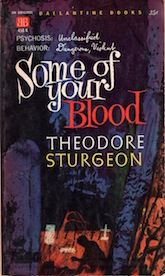…but first, a word:
As first lines go, the one that opens Theodore Sturgeon’s slim 1961 novel Some of Your Blood is deceptively simple. Just four little words, but already—thanks to those ellipses, thanks to that in medias res “but first”—Sturgeon pulls off two tricks: He creates instant suspense, and he draws the reader in as a conspirator. You didn’t know you were in the middle of hearing a secret before you opened the cover of this book, but thanks to that nameless narrator, now you do. And with the power of punctuation—that colon!—you embark on the story of “George,” a mental patient kicked out of the army for assaulting an officer.
Sturgeon plays a lot of tricks throughout Some of Your Blood, and he gets away with it by not playing them on the reader, but with the reader. From the outset, he brings you in as his collaborator to build a world that seems realistic enough—that is, until he upends your expectations of that reality with just a couple of lines about three-fourths of the way into the book. But by then, you’re complicit: You’ve not only bought what Sturgeon is selling, you helped make it real.
Buy the Book


Some of Your Blood
Just two pages after that first sentence, Sturgeon plays another trick, this one of reverse psychology. “This is fiction […] It is, it is, it really is fiction…,” the narrator assures you. But the repetition sounds like a child trying to convince you of a specious idea. It’s a tease, an elbow nudge to the ribs. Sure, we know it’s “fiction,” right, buddy? You’re too smart to fall for that, Sturgeon’s narrator implies; aren’t you?
We’ve broken into a psychologist’s office, our narrator informs us, to take a look at some confidential files. Turn the page, and we’re reading the documents: “Here is a typewritten letter […] The letters O-R over the date are in ink, printed by hand, large and clear,” the narrator introduces the first letter between Dr. Philip Outerbridge and Colonel Al Williams. What could be more official, more real, than secret, off-the-record military correspondence? Sure, it’s fiction…
Documentation is how Sturgeon solidifies his story in reality. Every element in the story he’s telling has a source: There are transcripts of interviews between Outerbridge and his patient, George; therapy notes on psychological tests and hypnosis sessions; more letters; and a sort of personal essay written by George in third person at the request of Outerbridge. If you flip through the pages of Some of Your Blood, it looks more like a science report than a horror/fantasy novel, and that’s the point. To convince us that his world is grounded in reality, Sturgeon gives us the most realistically mundane proof imaginable: paperwork.
Some of Your Blood wears its designation as a horror novel lightly. It doesn’t jump, cannonball-style, straight into its genre with a splash. Instead, it wades slowly into horror, staying close to the shore of reality for as long as it can. Then, when it starts to reveal itself for what it really is, you realize there were clues all along the way—as does Outerbridge when he writes, “…come to think of it, it’s right there in George’s autobiography. Will look that up. I bet it’s there to be read. I bet there are other things to be read in it now that we know the language…and George will fill in the gaps for us.”
Wait, there were gaps in George’s story? Now you’re flipping back to that essay, penned by George. A simple, straightforward tale about a dirt-poor country kid with an abusive father, a preference for solitude, and an interest in trapping critters in the woods around his home. Or so you assumed. But look closer: Here and there, George skips over important information. He elides details. He’s … maybe a little smarter than you first gave him credit for. You recall the transcriptions of the tests Outerbridge put George through, how his reactions to the Rorschach inkblots were a little … off. And the way he reacted when Outerbridge questioned him about his fondness for hunting? Maybe George isn’t as straightforward a guy as you thought.
Medical notes shouldn’t be chilling, but Outerbridge’s (“come to think of it, it’s [all] right there”) are. They stop you in your tracks and make you rethink everything you thought you knew. Moreover, they expose your collusion. By assuming George is one thing—by accepting the evidence you’ve been given as irrefutable—you’ve enabled George to get away with veiling the truth. Sturgeon’s greatest trick, perhaps, is giving you an unreliable narrator, then relying on the reader to convince herself that even if that narrator is unreliable, whatever the truth is, there will be a rational, reality-based explanation, available somewhere in all that paperwork.
Then, with just a couple sentences, Sturgeon upends everything you thought you knew and exposes the strange, unsettling, semi-supernatural reality of Some of Your Blood. Incredibly, he manages to not lose his reader when things suddenly turn fantastical, thanks to the way he grounds the story in reality before he tiptoes toward the surreal. Sturgeon keeps his reader believing all the way to the very end, when that nameless narrator from the opening pages returns to remind us: If we find what we’ve discovered about George too disturbing, it doesn’t matter. Don’t fret. After all, it’s just fiction. Isn’t it?
 Jamey Bradbury is a writer who lives in Anchorage, Alaska. Her fiction has appeared in Black Warrior Review (winner of the annual fiction contest), Sou’wester, and Zone 3 and won an Estelle Campbell Memorial Award from the National Society of Arts and Letters. She has written nonfiction for Alaska Dispatch News, TheBillfold.com, and StorySouth. Born in Illinois, Jamey has lived in Alaska for fifteen years, leaving briefly to earn her MFA from the University of North Carolina, Greensboro, after which she worked for two years as the assistant to the novelist John Irving. She has served in the Peace Corps and now works for an Alaska Native social services agency. Her novel The Wild Inside is now available from William Morrow.
Jamey Bradbury is a writer who lives in Anchorage, Alaska. Her fiction has appeared in Black Warrior Review (winner of the annual fiction contest), Sou’wester, and Zone 3 and won an Estelle Campbell Memorial Award from the National Society of Arts and Letters. She has written nonfiction for Alaska Dispatch News, TheBillfold.com, and StorySouth. Born in Illinois, Jamey has lived in Alaska for fifteen years, leaving briefly to earn her MFA from the University of North Carolina, Greensboro, after which she worked for two years as the assistant to the novelist John Irving. She has served in the Peace Corps and now works for an Alaska Native social services agency. Her novel The Wild Inside is now available from William Morrow.










